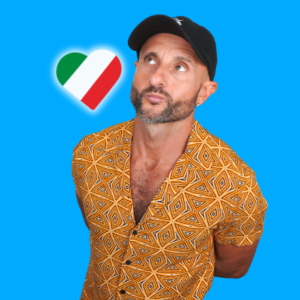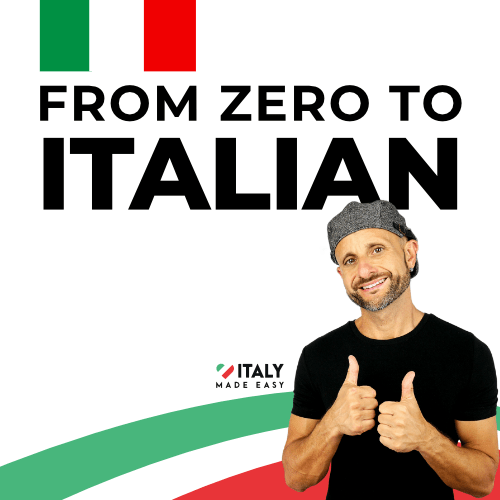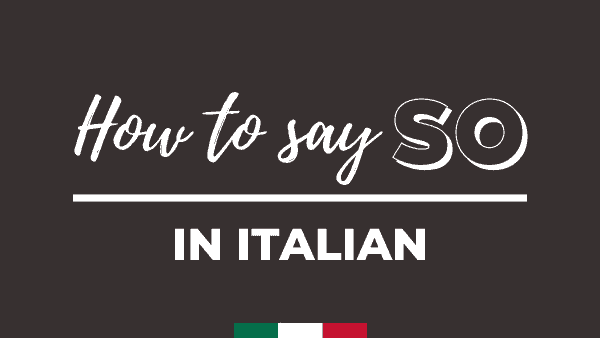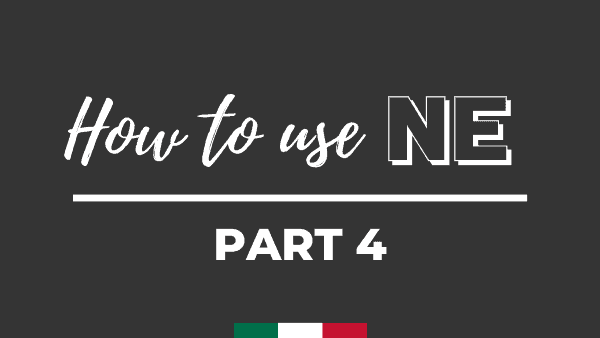The correct way to structure a sentence in Italian
Jun asks: “How do I structure sentences in Italian?“
Let's start from this assumption…
The first thing we want to address here is the fact that you are better off not worrying too much about the sentence structure in Italian and go with the general idea that Italian and English use a very similar structure, in most cases.
Download the PDF
No email required
Both Italian and English are S V O languages. That is:
Subject + Verb + Object
| IO | MANGIO | LA MELA |
| S | V | O |
| I | EAT | THE APPLE |
| S | V | O |
| JUN | STUDIA | ITALIANO |
| S | V | O |
| JUN | STUDIES | ITALIAN |
| S | V | O |
Of course you should remember that in Italian the subject is omitted in most cases and that Italian tends to use definite articles before the Object a lot more often than English does, but at the core, they are more similar than different.
Learn Italian to Fluency
- The program you've been dreaming of is here
- Better than having a private tutor
- In-Depth Italian lessons for complete clarity
- Extensive pratice opportunities
- Access to our community - you are never alone!
- A true learning experience to Italian Fluency
When is the structure different then?
When pronouns are involved in Italian, you have to remember that these go right before the verb!
My name is Manu
| (IO) | MI CHIAMO | MANU |
| S | V | O |
Technically speaking that “MI”, which means “myself” is already the Object of the sentence, but we prefer to just think of it as being part of the verb, so we don't get confused!
Alex loves me
| ALEX | MI | AMA |
| S | O | V |
Here the difference between English and Italian stands out, since to Object is clearly in the “wrong” place! But that's because pronouns (direct, indirect and reflexive) always go right before the verb.
Take it as a fact of life. A rule. The norm.
Alex does not love me
| ALEX | NON | MI | AMA |
| S | V | O | V |
When making the sentence negative things look even more weird, but again, what's happening is simply that the pronoun must go before the verb. And as usual the NON goes before the verb… so nothing too weird here, really!
Remember that in Italian we do not have words like DO, DOES, DID used in English to create questions, negative or emphatic sentences.
What happens in longer sentences?
Generally speaking, we'll have the same word order as English. Or better, the same order for the blocks of words that make up the sentence.
DOMANI VADO A FIRENZE PER UNA MOSTRA
Tomorrow I'm going to Florence to see an exhibition
Here we have the following “blocks” (groups of words that must remain together):
– DOMANI
– VADO A FIRENZE
– PER VEDERE UNA MOSTRA
While the previous sentence represents the most standard way of expressing our concept, in Italian we can freely shuffle the blocks around to confer a slightly different meaning.
We can say, for example:
VADO A FIRENZE PER VEDERE UNA MOSTRA DOMANI
By putting the DOMANI at the end of the sentence, we are stressing the WHEN we are doing something, rather than the WHAT we are doing (expressed in the first example above).
DOMANI VAI A FIRENZE PER VEDERE UNA MOSTRA
Tomorrow you are going to Florence to see an exhibition
DOMANI VAI A FIRENZE PER VEDERE UNA MOSTRA?
Tomorrow are you going to Florence to see an exhibition?
This last sentence often confuses you, since the structure in English would be different when we are asking a question.
But we can, in spoken English, do the same thing as in Italian, that is, asking a question using exactly the same structure as the statement, but raise our pitch:
Tomorrow you are going to Florence to see an exhibition (right)?
You see? Same structure as in Italian! No verb inversion, no DO's or DOES or DID's! 😉
Also remember that, in most cases, in Italian adjectives FOLLOW the noun they are describing.
QUESTO È UN LIBRO INTERESSANTE
This is an interesting book
It's tricky in questions…
The time when you really have to be alert and think about sentence structure in Italian should be when you're asking questions.
This is because questions do have a different structure from English. Let's have a look:
QUANDO ARRIVA IL BUS?
When does the bus arrive?
As you can see in Italian we start with the Question Word (just like in English) but then we put the verb, with the subject coming in last.
QUANTO COSTA QUESTO LIBRO?
How much does this book cost?
PERCHÉ È TRISTE MARIA?
Why is Maria sad?
Once again, Italian follows the structure:
QUESTION WORD + VERB + SUBJECT ….?
BUT WHY?
I'll be honest with you. That is not the best question you could ask. Languages do their own thing, no point in going crazy trying to understand why. Let's just get familiar with the “exception” and start using it!
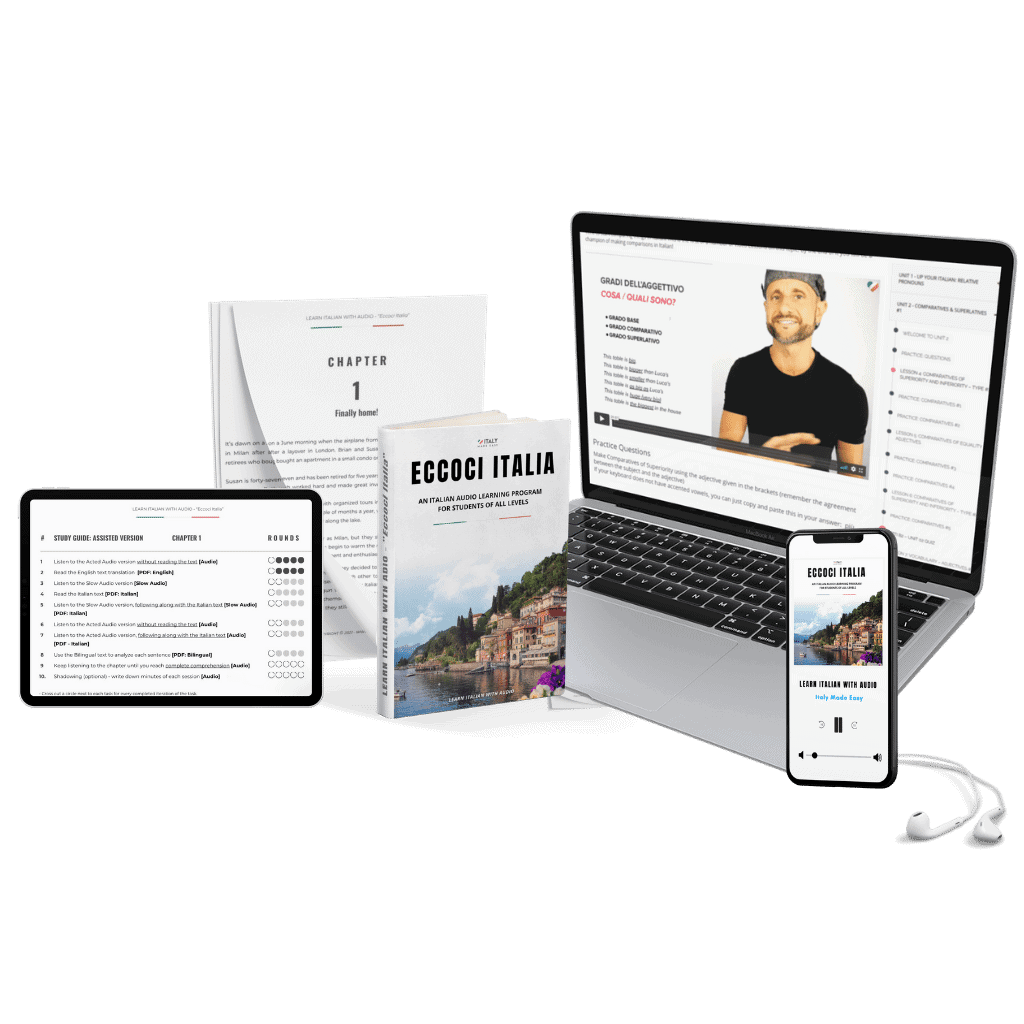
Understand spoken Italian
- Unique Course based on an Audio Novel in Italian
- Develop your comprehension of natural spoken Italian
- Learn to understand different Italian accents
- Follow along an entertaining Novel set in Italy
- 12 week program to take you to full comprehension
- A plethora of incredbly useful supporting resources
The secret to structuring questions
When using “Question Words” you must use this structure:
QUESTION WORD + VERB + SUBJECT …?
Question Words include:
- QUANDO = When
- DOVE = Where
- PERCHÉ = Why
- CHI = Who
- QUANTO = How much
- COME = How
- CHE COSA / CHE / COSA = What
- QUALE = Which
Just remember to have the verb immediately follow these words and throw the subject of your sentence after the verb, if you need to specify a subject.
Download the PDF
No email required
